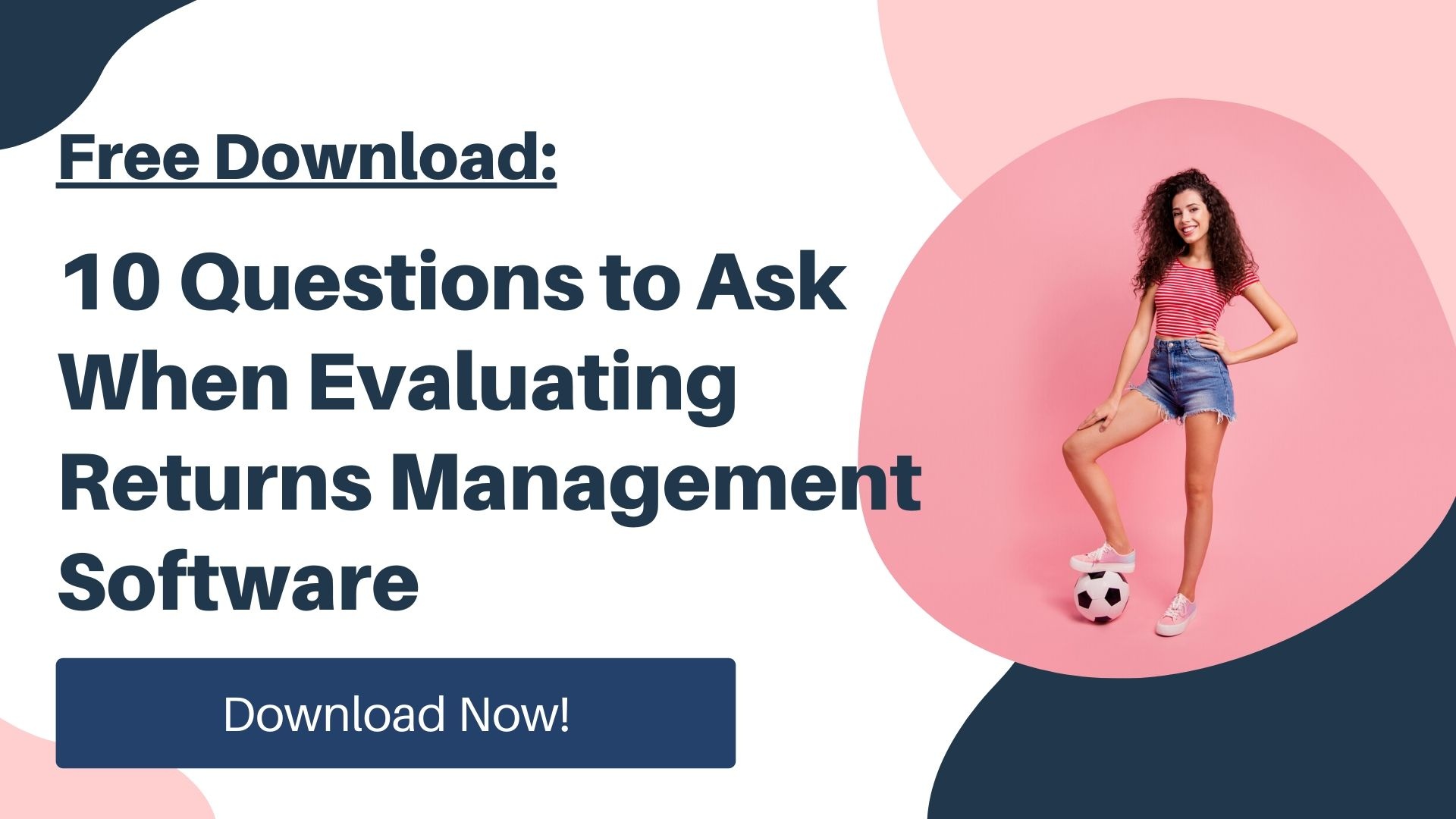How to Write an Ecommerce Return Policy That’ll Skyrocket Sales
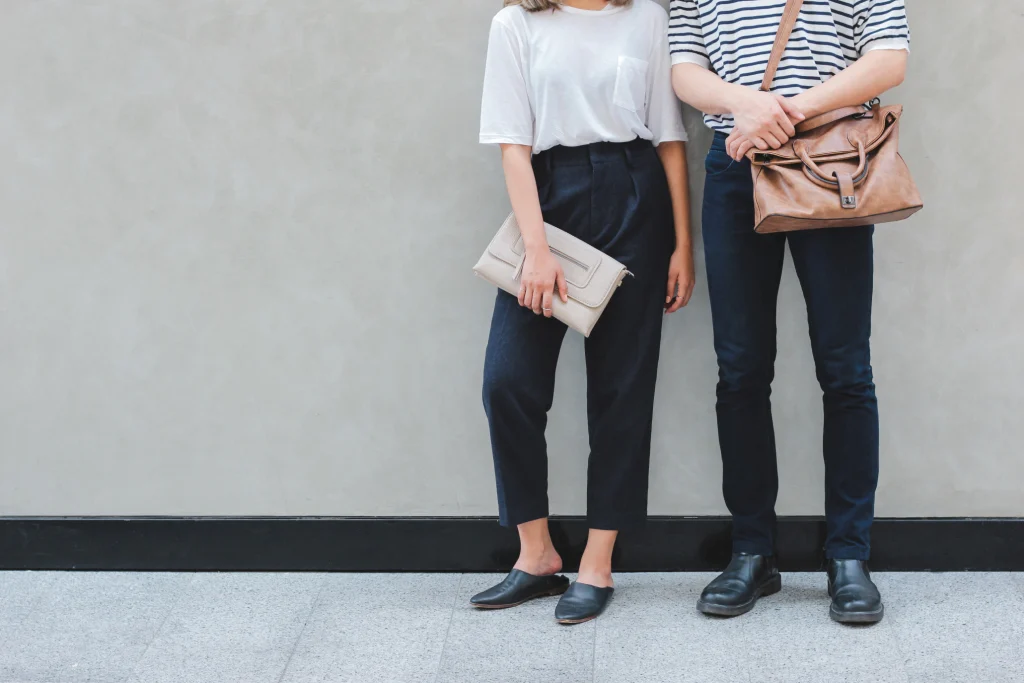
Ecommerce Return Policy:
An ecommerce return policy covers the rules for what can be returned & exchanged so all customers are treated fairly. They typically include information on the return window, supported return types, accepted return conditions, and who is responsible for return shipping.
How to Create an Ecommerce Return Policy to Boost Sales & Reduce Returns
When you’re navigating your retail brand through the enormous world of online retail, sometimes things slip through the cracks. Often your ecommerce return policy is one of those things.
Your return policy isn’t the most attractive thing that pops up when you think about your ecommerce business.
But what if, instead of being a pesky reminder that product returns still exist, your return policy could help retain customers and even drive sales?
Now we’re talking! But aren’t product returns bad for business? How could they possibly help my bottom line?
Two words: Customer Experience.
In this post, we’re going to create an ecommerce return policy that converts browsers into shoppers and new customers into lifetime brand champions.
Table of Contents:
- Return Policy Overview and Infographic
- Make Your Return Policy Easy to Find
- Use Easy to Understand Language
- Offer Free Return Shipping
- Set Clear Guidelines for What Can be Returned
- Create a Returns & Exchanges FAQ Page
- Personalize your Return Policy
- Adopt a More Liberal Return Policy
- Engage Shoppers Making a Return
- Illustrate The Hassle Free Return Process

How Your Ecommerce Return Policy Sets the Stage for Lifetime Customers
Happy customers play a huge role in the life of a healthy business. Happy customers are not only returning customers, but they’re also promoters of your brand.
Your return policy is a major factor in the customer’s journey and ultimately contributes to how satisfied a consumer is with your brand.
Having a customer-centric ecommerce return policy is one of the first steps in generating a positive customer experience. If your customer can envision a hassle-free interaction with your business by looking at your return policy, you’ve passively removed their pre-purchase anxiety.
Viewing your Ecommerce Return Policy as a Customer Acquisition Engine:
Thanks to a consumer-oriented return policy, a customer previously on the fence gains some reassurance to complete an order.
Then after they make the order, one of three things happens:
- The product they received aligns with the customer’s expectations and they’re satisfied.
- Something went wrong, and they keep the product.
- Something went wrong ,and they begin the return process.
The first is the preferred result, followed by the third.
The scariest outcome for an ecommerce retailer is case number two. Here you’ve got an unsatisfied shopper that’s unknown to you. This scenario is typically the result of a complex return process. Not only will this unsatisfied customer likely never purchase from your store again, they’ll tell their friends about their experience too.
A product return signifies a disappointed customer, but there’s a positive side to this story. You’re able to identify the shoppers who experience friction. This scenario gives you the power to turn this negative experience into a positive experience – one that they’re excited to share with their friends.
By leveraging an ecommerce return policy powered by the customer experience, each product return becomes an opportunity to impress the customer and convert them into a lifetime buyer.
With a smart ecommerce return policy, your customer will receive a seamless product return experience that translates into trust, quality, and efficiency in the eyes of the shopper — all major contributors to customer loyalty.
By following this 9-step guide to optimizing your ecommerce return policy, you’ll be able to drive in more sales, earn more lifetime customers, and improve your bottom line.
2. Make Your Return Policy Easy to Find
Consumers today want to feel confident before they’re ready to hand over their hard-earned cash. 66% of online shoppers review a store’s return policy before committing to a purchase.
With this many consumers doing pre-purchase research, it’s important to make your return policy easy to find and filled with value for the shopper.
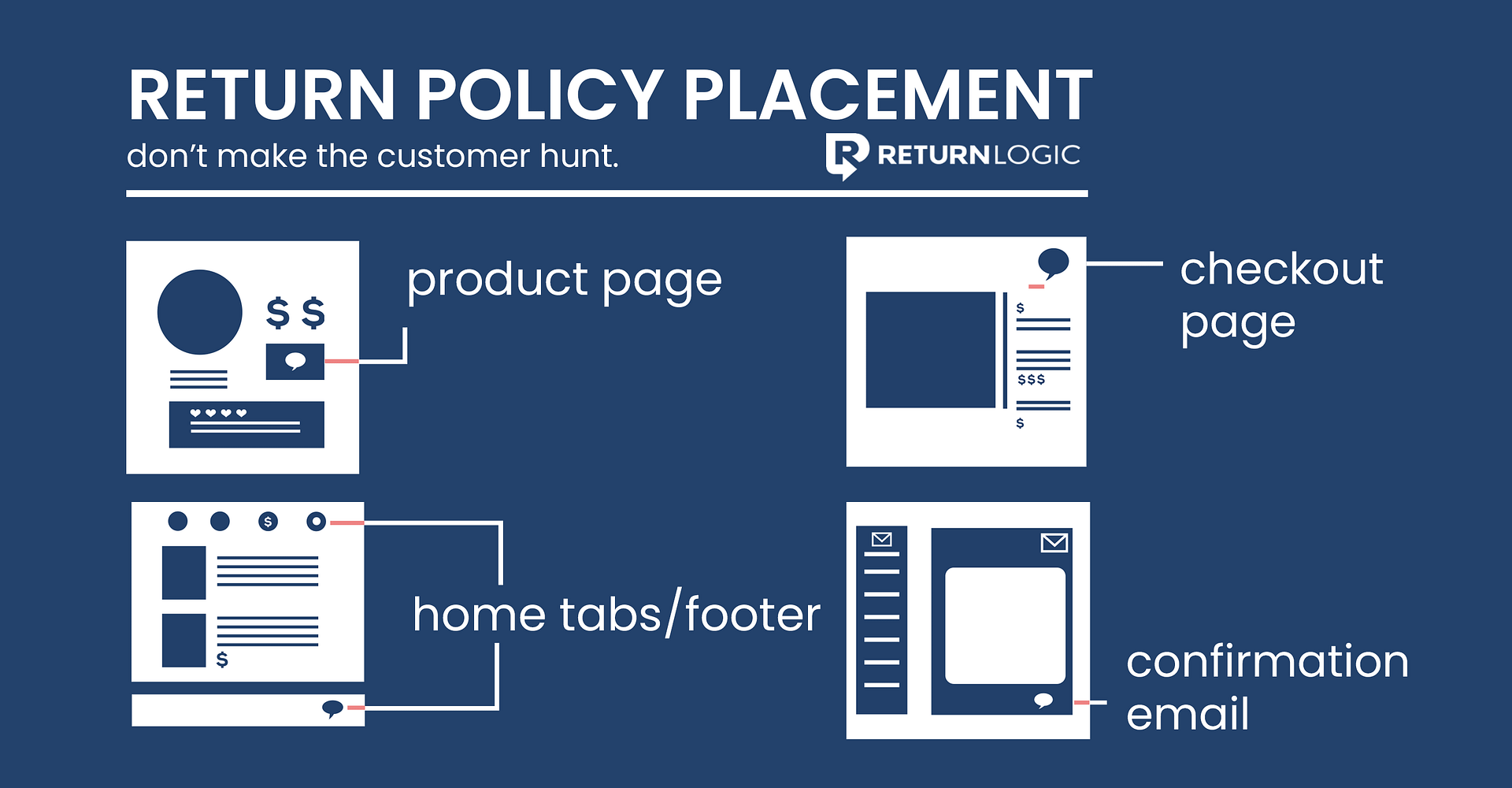
Too many online retailers shove their return policy under a pile of complicated terms and conditions that are only accessible through a vague link on the footer of their site.
Consumers are shopping online to save time, so you can guarantee they don’t want to be playing detective.
SheFit’s a great example of a retailer that highlights its return policy in the sales process. They feature a preview of their return & exchange process right on the product page so shoppers can easily see all the ecommerce return policy details.
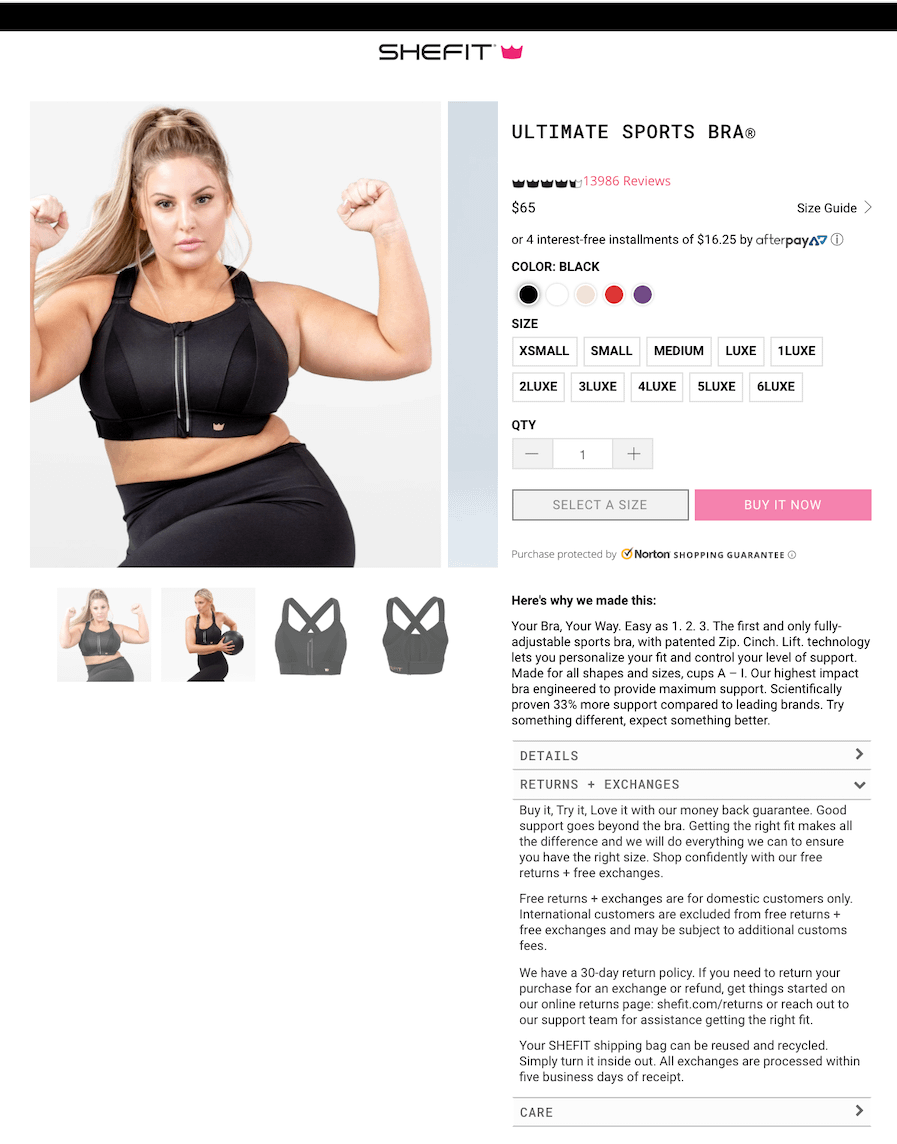
The Reset highlights the ease of their return process at the forefront of their marketing material.

Anaono does the same, leveraging hassle-free returns and exchanges right at the top of their homepage.

Here’s where we recommend you include your return policy for maximum visibility:
- On your Product Page: This placement will help encourage the sale of a product by keeping the product in the customer’s mind while they review your policy.
- On Your Home Page: Place a link to your return policy in an accessible location on your site’s homepage. Consumers are usually looking for a dedicated tab or link in the footer.
- During Checkout: It might seem counterproductive, but including a link to your ecommerce return policy in your checkout cart will encourage the customer to take the final step. Not only will including your return policy during the final stage of purchase help reduce cart abandonment, but it will also reaffirm your brand’s integrity.
- In the Confirmation Email: Placing your store’s return policy in the order confirmation email serves as the final reminder to the customer that your main priority is their satisfaction. It also shows them you’re willing to give them a hassle-free return experience if they’re not satisfied.
3. Use Easy to Understand Language
Often consumers are faced with complicated legalese when reading a retailer’s policies. Consumers don’t want to exert any effort decoding your complicated statements. Instead, they’ll move onto the next retailer.
To make sure consumers can purchase from your store with peace of mind, write your ecommerce return policy with a conversational and friendly tone.
Jon Josef does a great job of keeping their return policy simple and straightforward. For shoppers that have more questions, they link to their FAQ and Contact pages.
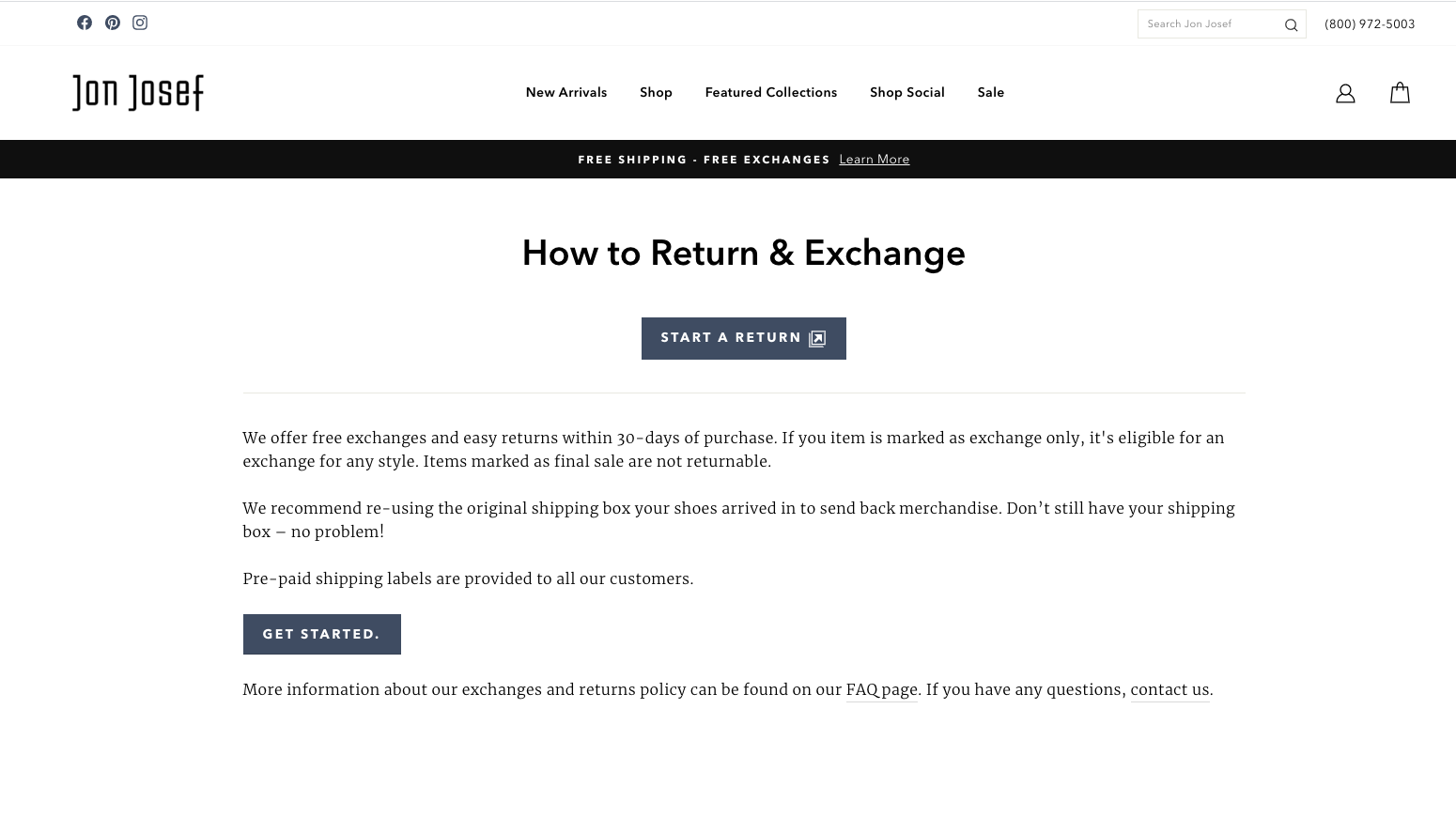
Avoid using authoritative language that commands the customer what to do; you want to make the ecommerce return process as painless as possible.
Peepers.com uses a simple 3-step process to illustrate how easy returns are for their shoppers.
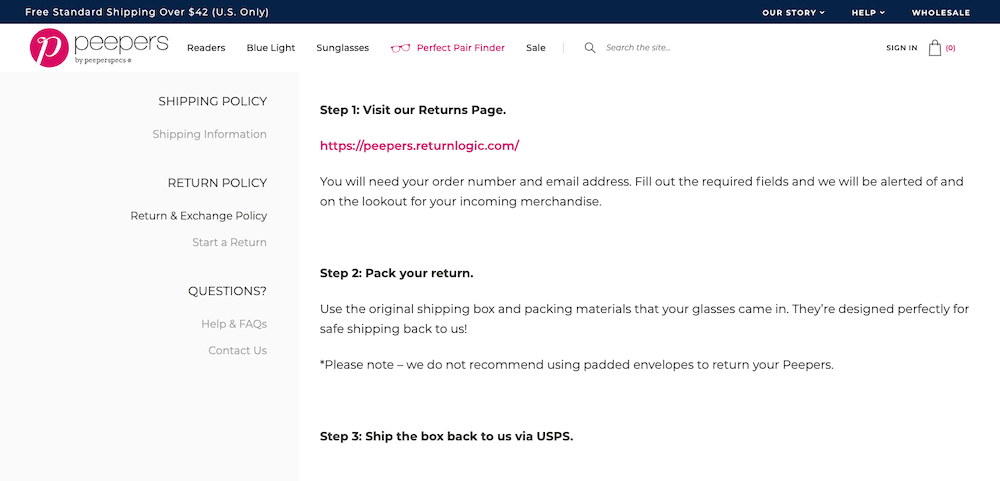
Understanding the return process before making a purchase gives the shopper additional confidence and improves the customer experience.
4. Provide Free Return Shipping
Offering free return shipping can be a great marketing tool to overcome pre-purchase anxiety.
The cost of providing free return shipping should be viewed in the context of the overall cost to acquire a customer.
If a shopper takes you up on the offer of free return shopping, it’s simply another opportunity to reengage them. If it costs $125 to acquire a customer, spending $7 for a return shipping label to retain that customer shouldn’t be an issue. It isn’t just an expense, it’s an investment in the future lifetime value of that shopper.
While there are arguments both for and against free returns shipping, the truth is customers already think returning a product is too much effort.
By incorporating free returns into your policy, you’re reassuring customers that they won’t be dealing with the extra hassle of shipping costs.
5. Set Clear Guidelines for What can be Returned
Make sure your customers fully understand the details of your return policy so they can handle the return process quickly and effectively.
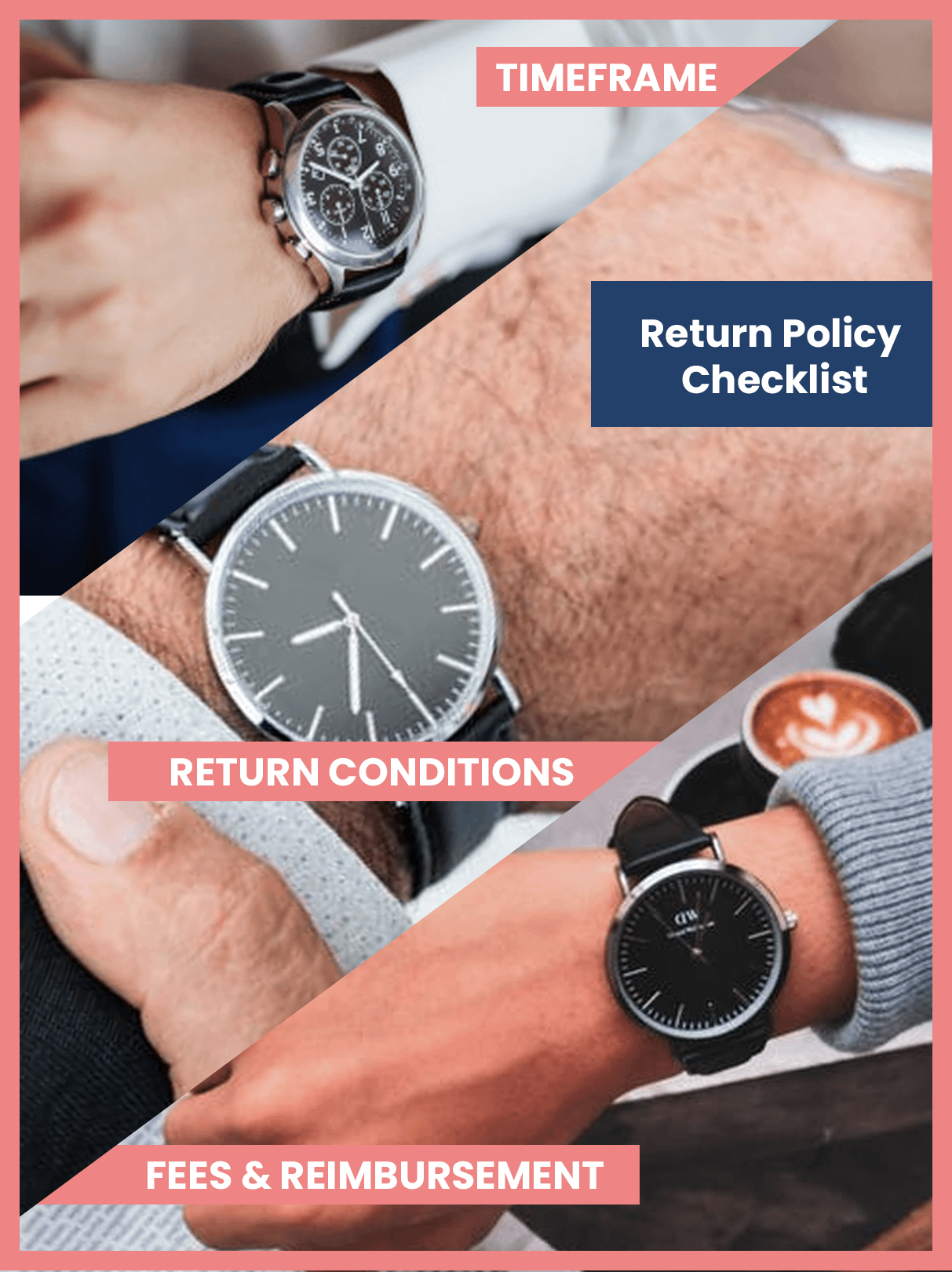
Laying out clear guidelines also limits what your customers can return and how that return will work.
Every Good Ecommerce Return Policy is Composed of the Following Elements:
Return Window:
The period in which your store accepts a product return and when the customer can expect a refund.
Depending on the product itself and any seasonal events or holidays that occur, you might want to vary this interval.
Provide a specific number of days that you will allow your consumers to return a product. Specify the number of days in which your consumers will receive the refund.
Return Conditions:
The terms for a valid return. There are various factors that you may need to look at, including:
- Packaging of an Item
- Where the Item was Purchased
- Hygiene Considerations
Reimbursement Options and Attached Fees:
Address all the refund options your customers have for their product return.
- Can consumers receive store credit, or exchange an item?
- List all the attached fees for an item, and explain why they occur.
- Think carefully about any deductions and fees that are a part of the returns process. Not all transactions are immediately apparent.
- Will international orders translate into different fees?
Groove Life does a great job setting shopper expectations on the finer details of how the return conditions impact the return policy.
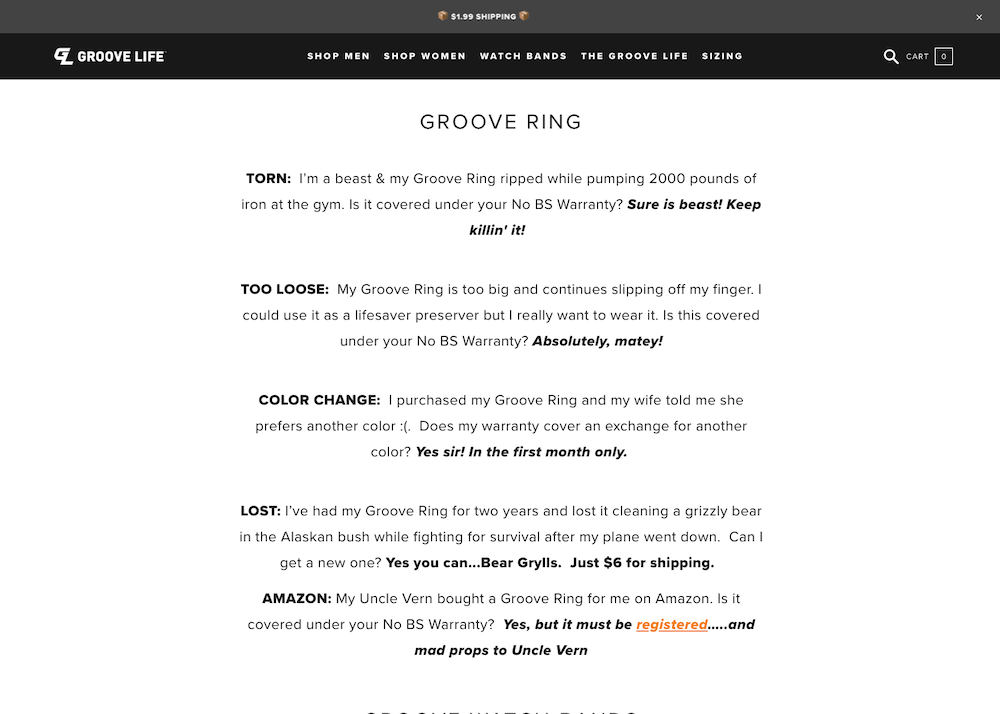
By clearly setting the boundaries for your product return policy, you’re giving customers clear expectations of your return process and protecting yourself from return fraud.
6. Create a Returns & Exchanges FAQ Page
Some ecommerce brands have FAQ pages dedicated to their products and stories – why not apply the same methodology to explain your return process?
Shopping online is all about saving time and money. Answers to common questions about your ecommerce return policy should be easy to find.
Enso Rings does this well, keeping answers to common questions simple.
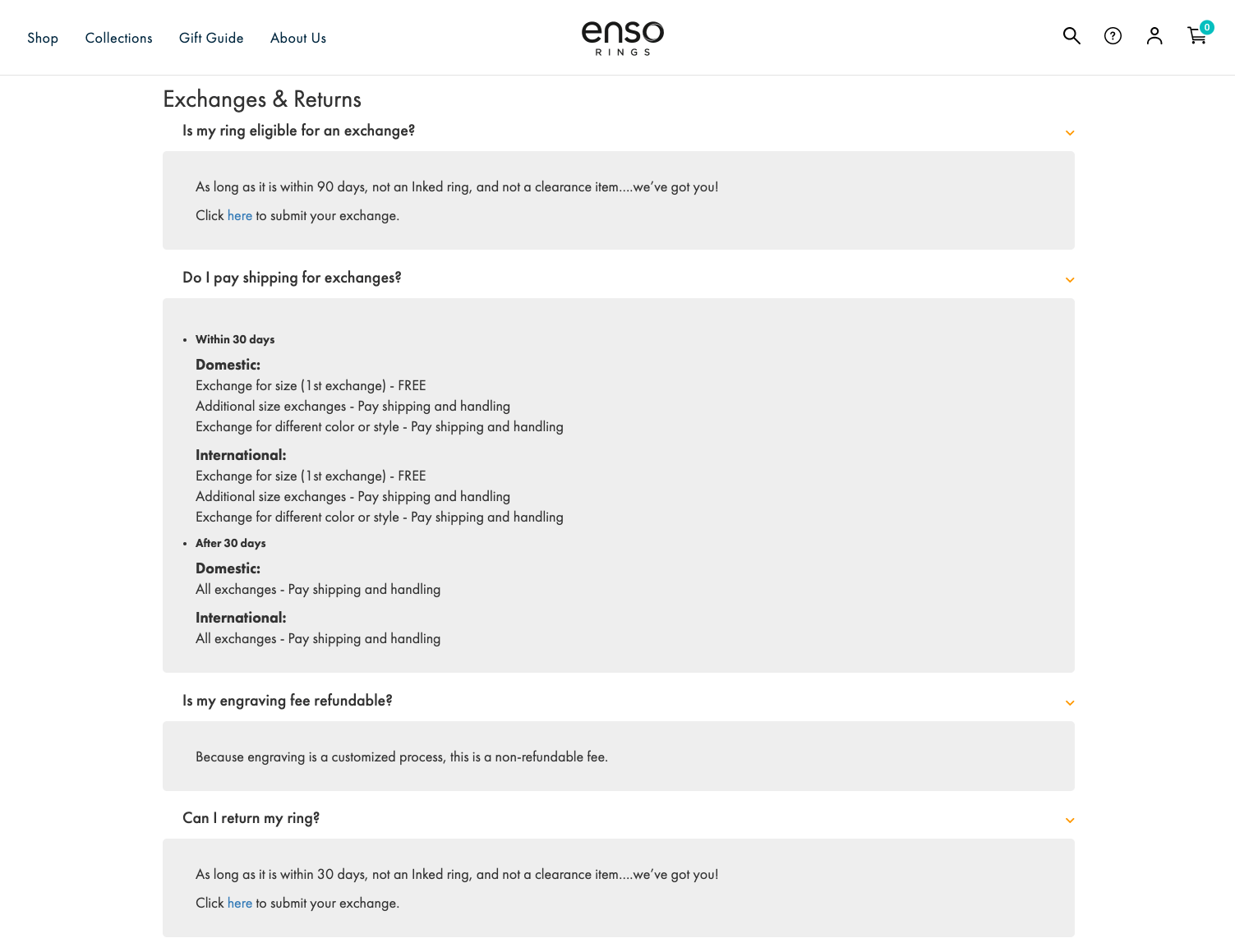
Jolyn uses a nesting FAQ page to help their shoppers quickly find the answers they’re looking for.
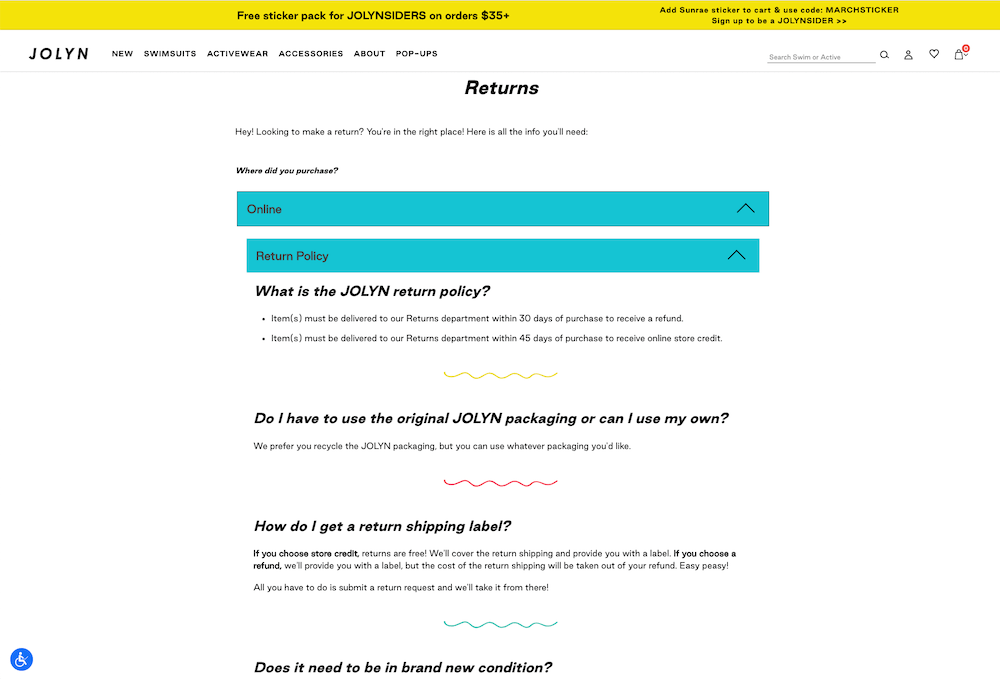
Incorporating returns into your FAQ page can steer customers towards answers that might save the sale, so remember to include any helpful documentation, tips, and guidelines so consumers can get the most out of the product.
Also, if you’ve got different returns policies for online, pop-ups, in-store, and marketplace purchases, be sure to address that in your Returns & Exchanges FAQ area.
7. Make Your Returns Policy Skim-able
Use your brand identity and voice to make your return policy engaging and creative. The idea is to separate the pain of a product return from the positive customer experience your business is trying to provide.
By phasing your company branding into a return policy, customers will become comfortable with the return process. Customer comfort is paramount because consumers will consider purchasing from a retailer again if they’re happy with the return policy.
Get creative when building your ecommerce return policy with photos, infographics, and video.
These additions make things more consumable for the customer and influence their decision to purchase from your store again.
AdoreMe illustrates the value of a creative return policy with icons and simple text that gives shoppers the confidence to move forward with a purchase.
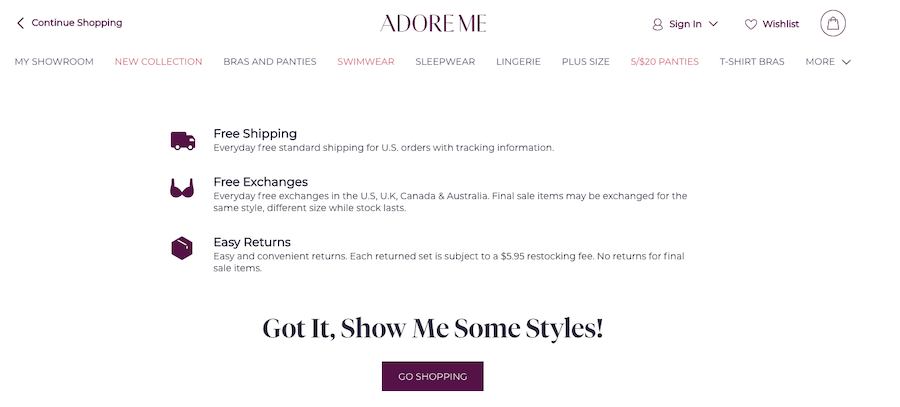
You don’t need to be a graphic designer to make this work. You can use tools like Canva to create fun graphics highlighting the main value props inside your return policy. It’s another way you can build a connection with your shoppers.
8. Adopt a More Liberal Return Policy
Shoppers are more likely to purchase a product if they know they can return it later. This behavior translates to increased product sales.
While more sales are great, retailers still need to craft a return policy that prevents those sales from becoming returns.
The obvious action would be to tighten up your return policy, right? Wrong; a more lenient return policy can actually prevent product returns.
Lengthen The Time Frame for Your Return Policy
According to research conducted by Narayanan Janakiraman, an Assistant Professor of Marketing at the University of Texas:
- An increase in the time consumers have to return a product translates into a decrease in return rate.
- Longer return periods alleviate the pressure consumers feel when faced with a short return deadline.
- Consumers spend more time with the product and are subject to the endowment effect, increasing one’s attachment to a product the longer the consumer has it in their possession.
- Consumers will forget to initiate the product return when a return window is longer.
Find the Optimal Time Frame
Many retailers opt for a standard 30-day return policy. While that interval provides customers with enough time to return a product, it doesn’t come with the benefits of a truly liberal return policy.
Retailers should take advantage of the endowment effect and consider increasing their return window to 60-90 days.
Balance this with the increased return liability of lengthening your return windows.
While there’s no magic number for your returns time frame, increasing the time shoppers can spend with their products can reduce your return rate.
9. Engage Shoppers Making a Return
Product returns damage the customer experience. And while providing a seamless and hassle-free return interaction will get retailers back on good terms with consumers, there still is no promise customers will return.
Jon Stern from Retention Rocket says retailers need to be proactive when considering the customer experience after every return.
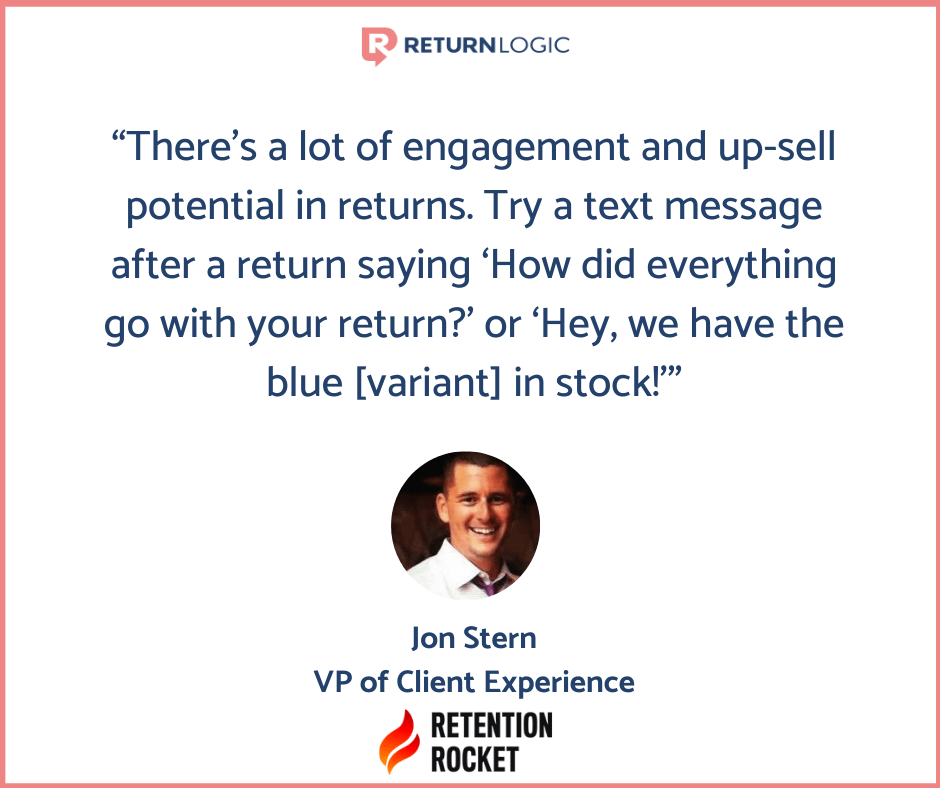
Proactive engagement will show the customer how much you value their business.
- Make sure to acknowledge the dissatisfaction the consumer endured.
- Subtly emphasize that you would appreciate them shopping with your store again
Noah Singer from Drip follows suit when discussing returns resulting from product quality issues:
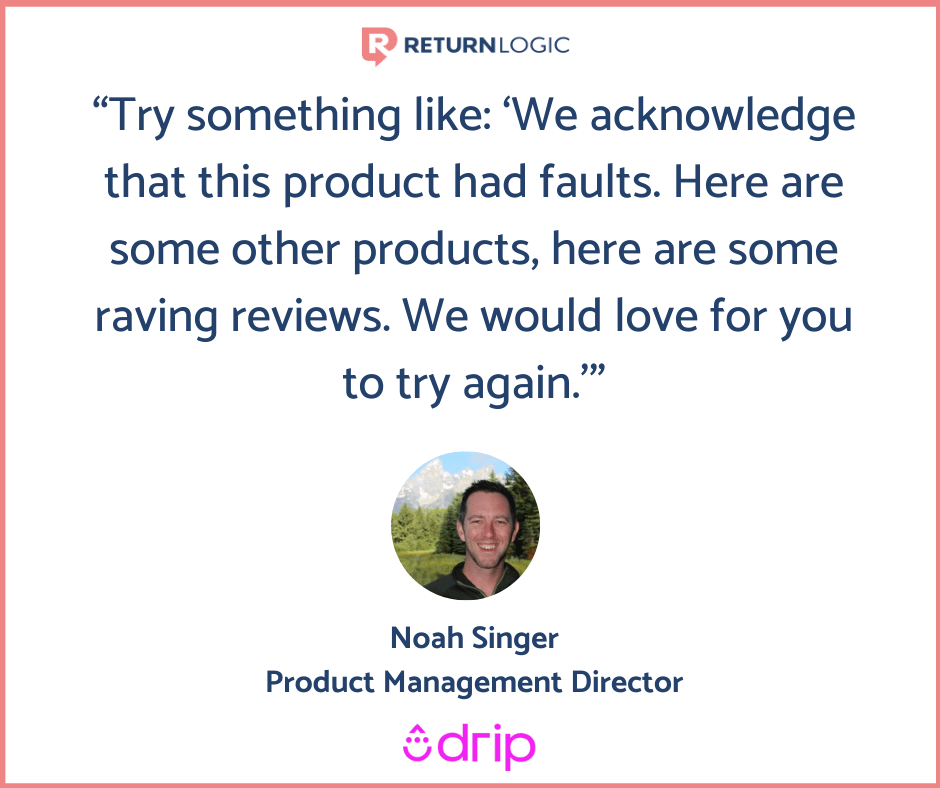
Not only does a thank you message show the consumer how much a retailer values their business, but it also opens up a new sales opportunity. By leveraging data and trends on their consumers, retailers can use incentives to reclaim consumers.
Along with your thank you message, include a discount towards the consumer’s next purchase. Some retailers are smart about their returns collection and have return reason codes attached to an order. By looking at the reason for a return, retailers might be able to offer a better discount.
Consumers generally gloss over answering disruptive survey questions. By thanking a consumer for a return, they will be much more receptive to providing valuable feedback you can use to increase sales and reduce returns.
10. Visualize your Hassle-Free Return Process
Amazon has trained consumers to expect easy and hassle-free returns. Shopify retailers need to present their return process similarly.
Consider creating a short product return guide to include within your policy. When a consumer can visualize the ease of a return, they will be more receptive to the idea of actually having to return the product, and therefore will continue the sale.
Allbirds uses icons and graphics to visualize what the shopper can expect in the return process.
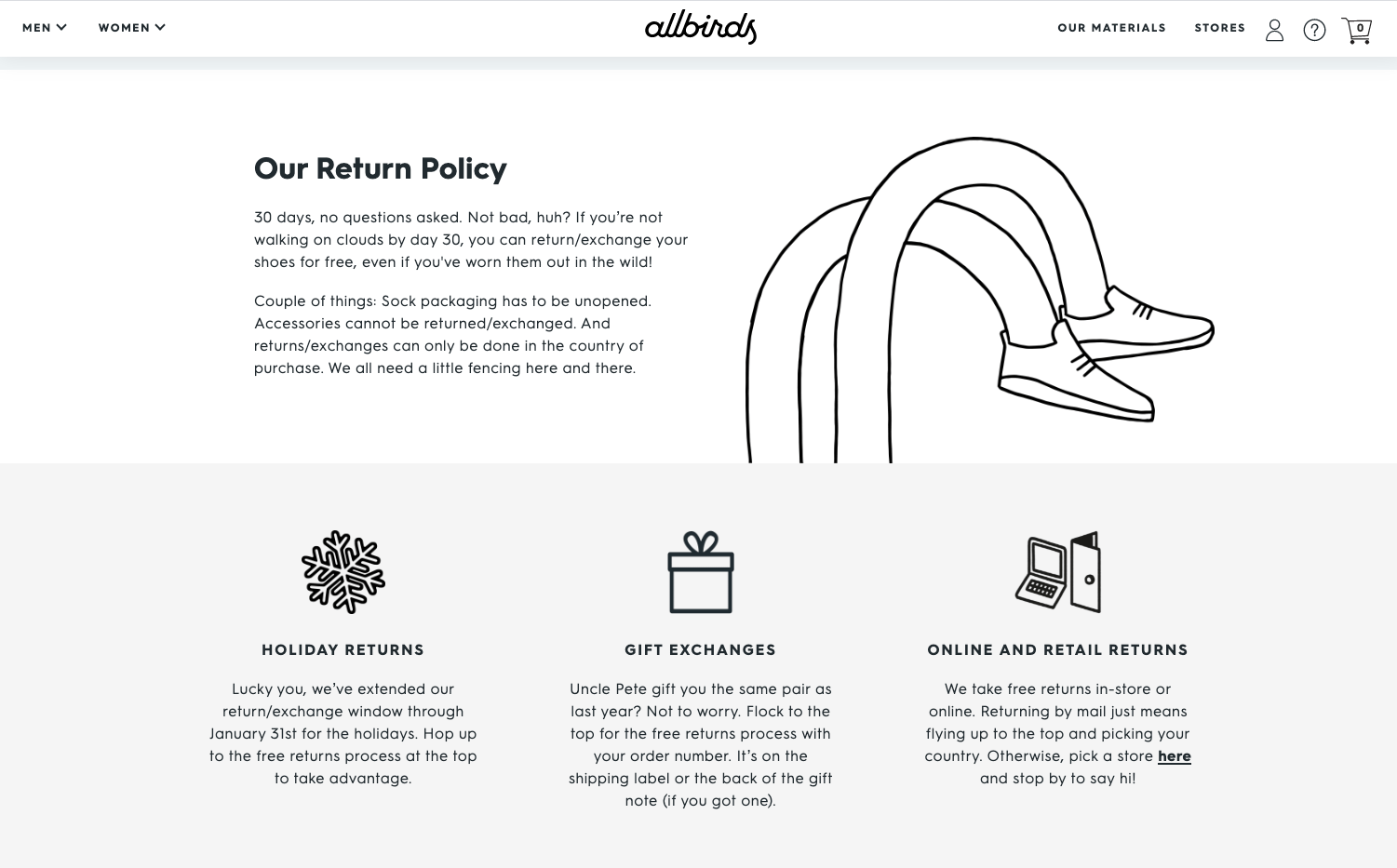
Emphasize a hassle-free experience.
Consumers will trust your business more if you can simplify a process and it explain it to them.
Key Takeaways:
By modifying your ecommerce return policy to be more customer-centric, you can drive sales and convert disappointed customers to lifetime buyers.
Retailers need to combine their customer-centric return policies with their logistics operations, marketing efforts, and sales forces to fully take advantage of a product return.
That’s the goal of return management solutions.
When crafting your new ecommerce return policy, keep these key ideas in mind:
- Consumers look at your return policy before they decide to make a purchase.
- Nearly two-thirds of consumers won’t even consider ordering from a retailer that doesn’t offer free returns.
- Think of free return shopping in light of customer acquisition costs. This will frame it as an investment in the lifetime value of the shopper.
- Make your policy easy to consume so shoppers can quickly digest and understand it.
- A good ecommerce return policy is liberal and protects against return fraud. After you achieve this balance, make your return policy easily accessible to the customer.
- Hassle-free interactions are the key to a positive return experience.
Your ecommerce return policy should serve as a marketing asset that helps convert a shopper overcome pre-purchase anxiety and become a paying customer.
If a customer takes you up on your offer to return a product, the process should be simple. Product returns signify a gap between a shopper’s expectations and reality.
Each product return you receive is another touchpoint with a hard-won customer. Use this opportunity to turn a lost sale into a loyal customer.
